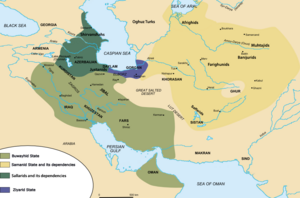| Iranian Intermezzo | |
|---|---|
 A map of Iran in the 10th century AD, during the Iranian Intermezzo with Buwayhid state, Samanid state and its dependencies, Sallarids and its dependencies, Ziyarid state and others. | |
| Date | 821–1055[1] |
| Location | |
| Resulted in |
|
| Lead figures | |
Iranian Intermezzo,[2] or Persian Renaissance,[3] was a period in Iranian history which saw the rise of various native Iranian Muslim dynasties in the Iranian Plateau, after the 7th-century Arab Muslim conquest and the fall of the Sasanian Empire. The period is noteworthy since it was an interlude between the decline of Abbāsid rule and power by Arabs and the "Sunni Revival" with the 11th-century emergence of the Seljuq Turks. The Iranian revival consisted of Iranian support based on Iranian territory and most significantly a revived Iranian national spirit and culture in an Islamic form,[4] although there were some Iranian Zoroastrian movements rejecting Islam altogether as a religion (e.g. Mardavij).[5] It also focused on reviving the Persian language, the most significant Persian-language literature from this period being the Shahnameh by Ferdowsi.[6] The Iranian dynasties and entities which comprised the Iranian Intermezzo were the Tahirids, Saffarids, Banu Ilyas, Ghaznavids, Sajids, Samanids, Ziyarids, Buyids, Sallarids,[7] Rawadids, Marwanids, Shaddadids,[8] Kakuyids, Annazids and Hasanwayhids.
According to the historian Alison Vacca, the Iranian Intermezzo "in fact includes a number of other Iranian, mostly Kurdish, minor dynasties in the former caliphal provinces of Armenia, Albania, and Azerbaijan".[8] The historian Clifford Edmund Bosworth states in the second edition of the Encyclopaedia of Islam that Minorsky considers the Rawadids to be flourishing during the period of the Iranian intermezzo.[9]
- ^ Encyclopædia Britannica: Persian dynasties.
- ^ Such an obviously coined designation was introduced by Vladimir Minorsky, "The Iranian Intermezzo", in Studies in Caucasian history (London, 1953) and has been taken up by Bernard Lewis, among others, in his The Middle East: A brief history of the last 2,000 years (New York, 1995).
- ^ Harter, Conrad Justin (2016). Narrative and Iranian Identity in the New Persian Renaissance and the Later Perso-Islamicate World (Thesis). University of California Irvine.
- ^ Bernard Lewis. The Middle East: 2,000 Years of History from the Rise of Christianity to the Present Day. pp. 81–82.
- ^ Robinson, Chase F. (4 November 2010). The New Cambridge History of Islamb. Vol. 1: The Formation of the Islamic World, Sixth to Eleventh Centuries. Cambridge University Press. ISBN 978-1-316-18430-1.
- ^ "Ferdowsi and the Ethics of Persian Literature". UNC-Chapel Hill Libraries. Retrieved 19 September 2023.
- ^ Vacca, Alison (2017). Non-Muslim Provinces under Early Islam: Islamic Rule and Iranian Legitimacy in Armenia and Caucasian Albania. Cambridge University Press. pp. 5–7. ISBN 978-1107188518.
- ^ a b Vacca, Alison (2017). Non-Muslim Provinces under Early Islam: Islamic Rule and Iranian Legitimacy in Armenia and Caucasian Albania. Cambridge University Press. p. 7. ISBN 978-1107188518.
The Iranian intermezzo in fact includes a number of other Iranian ethnic groups, mostly Kurdish, minor dynasties in the former caliphal provinces of Armenia, Albania, and Azerbaijan before the arrival of the Seljuks, such as the Kurdicized Arab Rawwādids in Azerbaijan and the Kurdish Marwānid family in eastern Anatolia from the tenth to the eleventh centuries. Finally, the most famous Kurdish dynasty, the Shaddādids, came to power in Dabīl/Duin in the tenth century, ruling until the twelfth. The Shaddādids named their children after Sasanian shāhanshāhs and even claimed descent from the Sasanian line. It is the other branch of the Shaddādid family, which controlled Ani, that Minorsky offers as the "prehistory" of Salāḥ al-Dīn.
- ^ Bosworth, C.E. (1995). "Rawwādids". In Bosworth, C. E.; van Donzel, E.; Heinrichs, W. P. & Lecomte, G. (eds.). The Encyclopaedia of Islam, Second Edition. Volume VIII: Ned–Sam. Leiden: E. J. Brill. ISBN 978-90-04-09834-3.